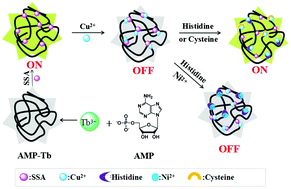Lanthanide coordination polymer nanoparticles as a turn-on fluorescence sensing platform for simultaneous detection of histidine and cysteine†
Abstract
In this work, we propose a strategy for the fluorescence assay of histidine (His) and cysteine (Cys) by using lanthanide coordination polymer nanoparticles (Ln-CPN) as a fluorescent probe. The Ln-CPN were prepared by self-assembly of adenosine monophosphate (AMP) with Tb3+, i.e. AMP-Tb. The nonluminescent AMP-Tb could be efficiently sensitized by 5-sulfosalicylic acid (SSA). The fluorescence of AMP-Tb-SSA can be remarkably quenched by Cu2+, and that of the resulting Cu/SSA/AMP-Tb can be significantly enhanced by His and Cys. Thus, a specific fluorescence “turn-on” assay for His and Cys was developed by using Cu/SSA/AMP-Tb as a sensing platform. The enhanced fluorescence intensity was proportional to the His and Cys concentration in the range from 0.2 to 150 μM and 0.5 to 200 μM, respectively, with the detection limits of 70 nM and 100 nM. Additionally, taking advantage of a masking agent for His, the differentiation of His from Cys was achieved in our system. Furthermore, the protocol can also work well for analyzing His and Cys in practical plasma samples with recovery in the range of 100.3–104.1%.



 Please wait while we load your content...
Please wait while we load your content...